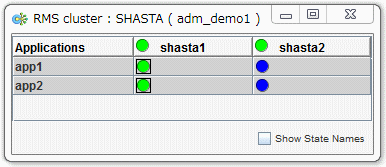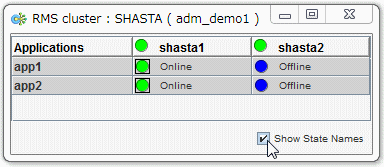The RMS clusterwide table displays the state of each application on each of the system nodes in a concise table.
To open the clusterwide table, right-click the cluster name (the root of the RMS tree in the left pane) and then select View Cluster Wide table from the context menu.
Figure 6.1 Opening the clusterwide table

The clusterwide table appears in a separate window.
Figure 6.2 Clusterwide table

To display the corresponding state name next to each status icon, click the Show State Names checkbox at the lower-right corner of the window.
Figure 6.3 Clusterwide table with state names

You can increase or decrease the size of the clusterwide table window and the size of the columns by using the mouse. If the window is already large enough to fully display all of the table elements, then you will not be allowed to further increase its size.
A square surrounding the colored state circle indicates the primary node for the application. "Figure 6.3 Clusterwide table with state names" above shows that shasta1 is the primary node for all of the applications.
Normally, the clusterwide table displays applications in alphabetical order from top to bottom. However, Faulted applications are handled specially. If an application is in the Faulted state on any node in the cluster, then it is displayed at the top of the table, and the application's name is highlighted by a pink background. This allows the System Administrator to easily spot any Faulted applications.
Figure 6.4 Faulted applications in the clusterwide table

The clusterwide table also makes special provisions for applications that are not online anywhere in the cluster. These applications are also displayed at the top of the table, with the application's name highlighted in light blue. This alerts the system administrator that some applications are not running anywhere and should probably be brought online on some node.
Figure 6.5 Offline applications in the clusterwide table

If there are both faulted applications and applications that are not online anywhere, then the faulted applications are listed first.
Figure 6.6 Faulted and offline applications in the clusterwide table

If there is a split-brain condition in the cluster on both the clusterwide table and the RMS tree, then colored exclamation marks will appear after the status icons (colored circles) of the nodes. A colored exclamation mark indicates that the state of that SysNode is different from what another SysNode views it as being. The color of the exclamation mark indicates the state that the other node thinks that the SysNode is in. If there are multiple nodes that see a SysNode in different states, you will see multiple exclamation marks after the colored circle. Exclamation marks are sorted according to the severity of the states.
The following figure shows a clusterwide table with an application of a split-brain condition. Note the yellow exclamation mark before the second node name.
Figure 6.7 Split-brain conditions in the clusterwide table

Note
Momentary split-brain conditions may be indicated while a node starts up or shuts down.